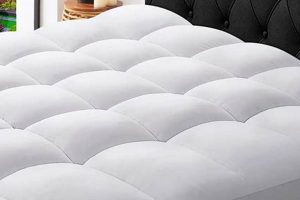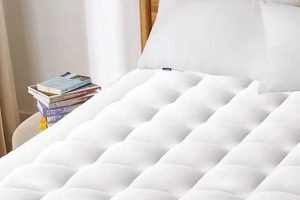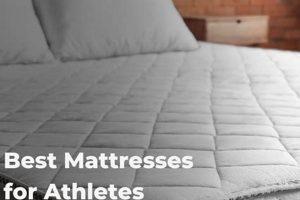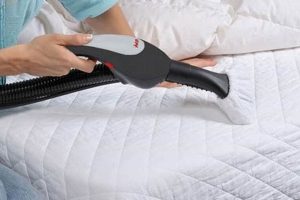A sleep surface designed to mitigate the discomfort associated with nocturnal hyperhidrosis is crucial for individuals experiencing this condition. These mattresses incorporate materials and construction techniques that prioritize temperature regulation and moisture wicking. As an example, mattresses utilizing open-cell foam structures or those incorporating natural fibers such as wool or cotton are often preferred due to their enhanced breathability.
The selection of an appropriate sleep surface significantly impacts sleep quality and overall well-being for those prone to overheating during sleep. Historically, advancements in mattress technology have focused on improving comfort, but the specific needs of individuals with temperature regulation challenges have become increasingly prominent. The benefits of such a sleep surface extend beyond mere comfort, potentially reducing sleep disruptions and promoting a more restful night.
The following sections will delve into the key characteristics of materials conducive to temperature regulation, explore various mattress types that excel in this area, and provide guidance on selecting the most suitable option based on individual needs and preferences.
Selecting an Appropriate Sleep Surface
Choosing a mattress optimized for temperature regulation involves careful consideration of materials, construction, and personal sleep preferences. The following guidelines provide a framework for making an informed decision.
Tip 1: Prioritize Breathable Materials: Natural fibers like cotton, wool, and bamboo offer enhanced breathability compared to synthetic alternatives. Open-cell foam structures also promote airflow, reducing heat retention.
Tip 2: Consider Cooling Technologies: Some mattresses incorporate phase-change materials or gel infusions designed to absorb and dissipate heat. These technologies can provide a noticeable cooling effect.
Tip 3: Evaluate Support and Comfort: Temperature regulation should not compromise support. A mattress that adequately supports spinal alignment is essential for long-term comfort and health.
Tip 4: Research Mattress Construction: Hybrid mattresses, which combine innerspring coils with foam layers, often offer a balance of support, comfort, and breathability. The coil system facilitates air circulation.
Tip 5: Assess Mattress Cover Fabric: The fabric of the mattress cover plays a crucial role in moisture wicking. Look for covers made from breathable materials that can help keep the sleep surface dry.
Tip 6: Adjust Bedding: Select bedding materials like sheets and blankets that contribute to temperature regulation. Breathable cotton or linen sheets can enhance the overall cooling effect of the mattress.
Tip 7: Check Reviews and Ratings: Consult reviews from other individuals experiencing nocturnal hyperhidrosis to gain insights into the performance of different mattress models.
By focusing on breathable materials, cooling technologies, and supportive construction, it is possible to identify a sleep surface that effectively addresses temperature regulation challenges. The selection of appropriate bedding further complements the mattress’s ability to maintain a comfortable sleep environment.
The subsequent sections will explore specific mattress types and brands that are recognized for their temperature-regulating properties.
1. Breathable Material Composition
The selection of breathable materials in mattress construction is paramount for individuals seeking to mitigate the effects of nocturnal hyperhidrosis. The composition of a mattress directly impacts its ability to dissipate heat and manage moisture, critical factors in maintaining a comfortable sleep environment.
- Open-Cell Foam Structures
Open-cell foam, unlike its closed-cell counterpart, possesses a porous structure that allows for increased airflow. This enhanced ventilation prevents the accumulation of heat within the mattress, reducing the likelihood of overheating and subsequent perspiration. Polyurethane foam, often used in mattress construction, is available in open-cell formulations designed to improve breathability. The result is a sleep surface that remains cooler throughout the night.
- Natural Fibers: Cotton and Wool
Natural fibers, particularly cotton and wool, exhibit inherent breathability and moisture-wicking properties. Cotton fibers allow air to circulate, while wool can absorb significant amounts of moisture without feeling damp. Incorporating these materials into the mattress cover or comfort layers helps regulate temperature and maintain a dry sleep surface. Mattresses employing these fibers offer a tangible advantage for those experiencing night sweats.
- Latex: Dunlop vs. Talalay
Latex, a natural material derived from rubber trees, is known for its durability and breathability. Dunlop latex tends to be denser, while Talalay latex undergoes a process that results in a more open-cell structure and superior airflow. Mattresses constructed with Talalay latex are often preferred for their enhanced cooling capabilities. The specific processing method significantly impacts the material’s ability to dissipate heat.
- Specialty Fabrics and Woven Designs
Advanced textiles, specifically designed for breathability and moisture management, are increasingly incorporated into mattress covers. These fabrics often utilize innovative weaving techniques that promote airflow and facilitate the evaporation of perspiration. The selection of the mattress cover material is often overlooked, but it plays a substantial role in temperature regulation. These specially designed fabrics are essential to maintain breathability.
In summary, the integration of breathable materialsopen-cell foam, natural fibers like cotton and wool, Talalay latex, and specialized cover fabricsis a decisive factor in the effectiveness of a mattress intended to alleviate night sweats. The selection of these materials should be a primary consideration for individuals seeking a cooler, drier, and more comfortable sleep experience.
2. Effective Moisture-Wicking Capability
Effective moisture-wicking capability is a critical attribute of a mattress designed to mitigate the discomfort associated with nocturnal hyperhidrosis. The ability of a mattress to draw moisture away from the body contributes directly to a drier, more comfortable sleep environment, positively impacting sleep quality.
- Fiber Structure and Capillary Action
The structure of mattress fibers directly influences moisture transport. Hydrophilic fibers, like wool and cotton, possess a natural affinity for water, drawing moisture
away from the skin through capillary action. This mechanism allows the mattress to absorb perspiration and maintain a dry surface feel. The effectiveness of this action is contingent on the fiber’s inherent properties and density within the mattress layers. - Airflow and Evaporation Rates
Moisture wicking is not solely about absorption; it also necessitates efficient evaporation. Mattresses with enhanced airflow promote the evaporation of absorbed moisture, preventing saturation and maintaining a comfortable temperature. Open-cell foam structures and strategically placed ventilation channels facilitate this process. The rate of evaporation is dependent on the mattress’s internal structure and the ambient environmental conditions.
- Material Composition and Blend Optimization
The combination of different materials within a mattress can optimize moisture-wicking performance. Blending hydrophilic fibers with hydrophobic synthetics can create a system that both absorbs and disperses moisture effectively. Layering materials strategically ensures that moisture is drawn away from the body and allowed to evaporate. Careful material selection maximizes moisture-wicking capabilities.
- Textile Treatments and Surface Modifications
Textile treatments, such as those that impart antimicrobial and hydrophobic properties, can further enhance moisture management. These treatments can prevent the growth of mold and bacteria, which thrive in moist environments, and promote faster drying times. Surface modifications, such as specialized weaves, can also increase the surface area available for evaporation. Such advanced treatments boost the benefits.
In conclusion, effective moisture-wicking capability in a mattress relies on a combination of fiber properties, airflow dynamics, material composition, and textile treatments. These factors synergistically contribute to a drier and more comfortable sleep environment, making them essential considerations when selecting a mattress intended to alleviate the symptoms of nocturnal hyperhidrosis and establishing them as crucial for any product marketed as a temperature regulating option.
3. Optimal airflow design
Optimal airflow design constitutes a fundamental element in a mattress intended to mitigate the discomfort associated with nocturnal hyperhidrosis. The capacity of a mattress to facilitate air circulation directly impacts its ability to regulate temperature and manage moisture, two crucial factors in ensuring a restful sleep. The lack of adequate airflow can result in heat retention and moisture accumulation, exacerbating the effects of night sweats and disrupting sleep patterns. Conversely, mattresses engineered with enhanced airflow promote the dissipation of body heat and the evaporation of perspiration, contributing to a cooler and drier sleep surface. For example, mattresses employing open-cell foam structures or incorporating strategically placed ventilation channels demonstrate superior airflow characteristics compared to those constructed with dense, non-breathable materials. The inclusion of these design features directly contributes to the mattress’s effectiveness in managing temperature and moisture, thereby improving comfort for individuals experiencing night sweats.
The implementation of optimal airflow design extends beyond material selection to encompass the overall construction of the mattress. Hybrid mattresses, which combine innerspring coils with foam layers, often exhibit enhanced airflow due to the open spaces between the coils. These coils act as conduits for air circulation, preventing heat buildup within the mattress core. Furthermore, the strategic placement of ventilation channels within the foam layers can further enhance airflow, directing warm air away from the sleeper and promoting the influx of cooler air. The effectiveness of airflow design can also be influenced by the mattress cover fabric. Breathable fabrics, such as those made from natural fibers or engineered synthetics, allow air to circulate freely, complementing the internal airflow mechanisms of the mattress. Without a focus on airflow, even the most advanced materials cannot effectively dissipate heat and manage moisture, rendering the mattress less suitable for individuals prone to overheating during sleep.
In summary, optimal airflow design is not merely a desirable feature but an essential component of a mattress designed to address night sweats. The ability to promote air circulation and facilitate heat dissipation directly impacts the mattress’s effectiveness in regulating temperature and managing moisture. While material selection and construction techniques contribute to airflow, the ultimate goal is to create a sleep environment that minimizes heat retention and promotes evaporation, thereby enhancing comfort and improving sleep quality. The challenge lies in balancing airflow with other essential mattress characteristics, such as support and comfort, to create a holistic solution for individuals seeking relief from nocturnal hyperhidrosis.
4. Temperature Regulation Technology
The efficacy of a sleep surface in mitigating nocturnal hyperhidrosis is directly correlated with its implementation of temperature regulation technology. The cause-and-effect relationship is evident: mattresses incorporating advanced cooling technologies demonstrably reduce heat retention, thereby minimizing perspiration and fostering a more comfortable sleep environment. Temperature regulation technology is not merely an ancillary feature but a core component of a mattress designed to address night sweats. For instance, phase-change materials (PCMs) embedded within the mattress layers absorb and release heat, moderating temperature fluctuations throughout the night. Similarly, gel-infused foams dissipate heat away from the body, preventing overheating. The presence and effectiveness of these technologies significantly determine the appropriateness of a mattress for individuals experiencing night sweats.
Practical applications of temperature regulation technology extend beyond material selection. Mattress designs often incorporate ventilation channels and strategically placed perforations to enhance airflow, further facilitating heat dissipation. Furthermore, some mattresses employ active cooling systems, utilizing integrated fans or water circulation mechanisms to maintain a consistently cool sleep surface. The selection of appropriate bedding materials, such as breathable cotton or linen sheets, complements the mattress’s cooling capabilities, creating a synergistic effect. The practical significance of understanding these technologies lies in the ability to make informed purchasing decisions, selecting mattresses that offer tangible benefits in terms of temperature regulation and sleep quality.
In summary, temperature regulation technology is inextricably linked to the performance of mattresses designed for night sweats. These technologies directly impact heat retention and moisture management, crucial factors in creating a comfortable sleep environment. While challenges remain in optimizing cooling performance and balancing it with other mattress characteristics, the advancements in temperature regulation technology offer promising solutions for individuals seeking relief from nocturnal hyperhidrosis. The comprehension of these technologies enables consumers to make informed choices, selecting mattres
ses that effectively address their specific needs and preferences.
5. Adequate support structure
The presence of an adequate support structure within a mattress is not merely a comfort consideration; it is a critical factor that directly influences the effectiveness of a sleep surface designed to mitigate nocturnal hyperhidrosis. Proper spinal alignment and pressure distribution contribute to overall sleep quality, indirectly impacting temperature regulation and moisture management. A mattress lacking sufficient support can lead to discomfort, restlessness, and increased heat retention, thereby exacerbating the symptoms of night sweats.
- Spinal Alignment and Muscle Relaxation
A well-supported spine promotes muscle relaxation, reducing tension and minimizing heat production during sleep. Conversely, a sagging or unsupportive mattress forces muscles to work harder to maintain proper alignment, leading to increased body temperature and potential sweating. The correlation between spinal alignment and thermal regulation underscores the importance of selecting a mattress with adequate support. For example, a medium-firm mattress is generally recommended for back sleepers to maintain spinal alignment, while side sleepers may benefit from a softer surface that contours to the body and alleviates pressure points. The type of support will determine how the body reacts.
- Pressure Distribution and Circulation
An adequate support structure ensures even pressure distribution across the body, preventing localized pressure points that can restrict circulation and increase local temperature. Mattresses with zoned support systems, for instance, provide targeted reinforcement in areas where pressure is concentrated, such as the hips and shoulders. Improved circulation, in turn, promotes efficient heat dissipation and reduces the likelihood of overheating. Pressure distribution is key to managing localised overheating, impacting the whole sleep experience.
- Material Density and Durability
The density and durability of the materials used in the support core directly impact the mattress’s ability to maintain its shape and provide consistent support over time. A low-density or poorly constructed support core is more likely to sag or compress, leading to spinal misalignment and increased pressure points. Mattresses with high-density foam or robust innerspring systems offer superior support and durability, ensuring that the mattress continues to provide adequate support throughout its lifespan. Material quality is pivotal for sustained effectiveness. Over time, low-quality mattresses will perform worse.
- Edge Support and Usable Surface Area
Adequate edge support maximizes the usable surface area of the mattress and prevents roll-off, particularly for individuals who share a bed. Strong edge support allows sleepers to utilize the entire mattress surface, promoting even weight distribution and reducing the likelihood of concentrated pressure and heat build-up. A mattress with weak edge support can create a confined sleep space and contribute to increased heat retention. Sleeping position affects the benefit of edge support. Those close to the edge or sharing a bed benefit most.
In conclusion, an adequate support structure is an indispensable element of a mattress designed to address nocturnal hyperhidrosis. By promoting spinal alignment, distributing pressure evenly, maintaining material integrity, and maximizing usable surface area, a well-supported mattress indirectly contributes to temperature regulation and moisture management. The selection of a mattress with a robust support structure is therefore essential for individuals seeking to minimize the discomfort associated with night sweats and improve their overall sleep quality.
6. Hypoallergenic properties
The inclusion of hypoallergenic properties in a mattress designed to address nocturnal hyperhidrosis is significantly relevant due to the heightened susceptibility to allergens associated with increased moisture. A moist environment, frequently resulting from night sweats, provides an ideal breeding ground for dust mites, mold, and bacteria. These allergens can trigger allergic reactions and respiratory issues, further disrupting sleep quality and potentially exacerbating existing health conditions. Therefore, the presence of hypoallergenic materials and construction techniques becomes not merely a comfort enhancement but a proactive measure to mitigate potential health risks. For instance, a mattress utilizing natural latex, known for its inherent resistance to dust mites and mold, directly reduces the allergenic load within the sleep environment. The incorporation of such properties underscores the holistic approach required when selecting a sleep surface intended to alleviate night sweats. The practical implication of this understanding is that consumers prioritize mattresses certified as hypoallergenic or constructed with materials known for their inherent resistance to allergens.
Practical applications of hypoallergenic properties in mattresses extend to the use of tightly woven encasements that prevent dust mites from penetrating the mattress core. Similarly, antimicrobial treatments applied to mattress surfaces inhibit the growth of bacteria and mold, further reducing the allergenic potential. Real-world examples include individuals with allergies or asthma experiencing a noticeable reduction in symptoms upon switching to a hypoallergenic mattress. These benefits often extend to improved sleep quality and reduced reliance on allergy medications. The selection of appropriate bedding materials, such as hypoallergenic pillowcases and sheets, complements the mattress’s hypoallergenic properties, creating a comprehensive allergen-resistant sleep environment. Selecting appropriate bedding materials are also significant in mattresss hypoallergenic properties
In summary, the inclusion of hypoallergenic properties is a crucial consideration when selecting a mattress for night sweats. The combination of increased moisture and potential allergen exposure necessitates a proactive approach to mitigating potential health risks. While challenges remain in completely eliminating allergens from the sleep environment, the advancements in hypoallergenic materials and construction techniques offer tangible benefits for individuals seeking relief from nocturnal hyperhidrosis and its associated health concerns. Prioritizing these features ensures a cleaner, healthier, and more restful sleep experience. In effect, this promotes good sleep quality for the sleepers
Frequently Asked Questions
The following questions address common concerns and misconceptions regarding sleep surfaces designed to mitigate the discomfort associated with nocturnal hyperhidrosis. These answers provide factual information to facilitate informed decision-making.
Question 1: What constitutes the “best mattress for night sweats,” and what key features differentiate it from standard mattresses?
The term designates a sleep surface specifically engineered to regulate temperature and manage moisture. Key differentiators include the utilization of breathable materials (e.g., open-cell foam, natural fibers), advanced cooling technologies (e.g., phase-change materials, gel infusions), and enhanced airflow designs (e.g., ventilation channels). Standard ma
ttresses often lack these specialized features, resulting in increased heat retention and discomfort for individuals prone to overheating.
Question 2: Can a mattress truly eliminate night sweats?
No sleep surface can entirely eliminate nocturnal hyperhidrosis, as the underlying cause is often physiological or environmental. However, the appropriate mattress can significantly reduce the severity and impact of night sweats by promoting a cooler, drier sleep environment. It serves as a management tool rather than a cure.
Question 3: Are mattresses marketed as “cooling” or “temperature-regulating” universally effective for all individuals experiencing night sweats?
Individual responses to mattresses claiming cooling properties vary. Factors such as body temperature, ambient room temperature, and bedding materials influence the effectiveness of any temperature-regulating sleep surface. Researching product specifications and consulting reviews from individuals with similar needs is advisable.
Question 4: How does mattress material impact its suitability for addressing night sweats?
Mattress material plays a crucial role. Open-cell foam and natural fibers (cotton, wool) promote airflow and moisture wicking, while closed-cell foam and synthetic materials tend to retain heat. Latex, particularly Talalay latex, offers a balance of support, breathability, and durability. Selecting materials aligned with temperature regulation is essential.
Question 5: What role does mattress construction play in mitigating night sweats?
Mattress construction significantly influences airflow and heat dissipation. Hybrid mattresses, combining innerspring coils with foam layers, often provide superior ventilation compared to all-foam mattresses. The presence of ventilation channels and strategic material layering further enhances temperature regulation.
Question 6: Beyond the mattress itself, what additional steps can individuals take to manage night sweats during sleep?
Complementary measures include selecting breathable bedding materials (cotton, linen), maintaining a cool room temperature, avoiding heavy blankets, and addressing any underlying medical conditions contributing to nocturnal hyperhidrosis. A holistic approach encompassing lifestyle adjustments and environmental controls is recommended.
In summary, selecting an appropriate mattress constitutes a significant but not solitary step in managing nocturnal hyperhidrosis. A comprehensive approach addressing environmental factors, bedding choices, and potential underlying medical conditions is often necessary.
The subsequent section explores specific mattress types and brands frequently recommended for individuals experiencing night sweats.
Conclusion
The exploration of “best mattress for night sweats” has highlighted the critical interplay between material composition, construction techniques, and individual needs. Mattresses designed to address nocturnal hyperhidrosis prioritize breathability, moisture-wicking capability, optimal airflow design, and temperature regulation technology, all underpinned by an adequate support structure and hypoallergenic properties. The absence of these features compromises the effectiveness of any sleep surface intended to alleviate night sweats.
The selection of a suitable mattress represents a significant investment in sleep quality and overall well-being. Individuals experiencing persistent nocturnal hyperhidrosis should consult with healthcare professionals to rule out underlying medical conditions and explore comprehensive management strategies. Continued research and development in materials science and sleep technology hold the promise of further advancements in sleep surfaces tailored to specific physiological needs.



![Top-Rated Best Mattress for Adjustable Base Frames [Guide] Organic & Natural Mattress Buyer’s Guide: Non-Toxic Sleep Solutions Top-Rated Best Mattress for Adjustable Base Frames [Guide] | Organic & Natural Mattress Buyer’s Guide: Non-Toxic Sleep Solutions](https://mattressworldpa.com/wp-content/uploads/2025/07/th-7599-300x200.jpg)



